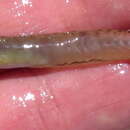Diagnostic Description
provided by Fishbase
Dark bar under eye; tan in color, with dark spots above; sides with 6-10 vertical bars; large specimens with black margined dorsal and anal fins; caudal fin with oblique bands (Ref. 2798).
- Recorder
- Cristina V. Garilao
Migration
provided by Fishbase
Amphidromous. Refers to fishes that regularly migrate between freshwater and the sea (in both directions), but not for the purpose of breeding, as in anadromous and catadromous species. Sub-division of diadromous. Migrations should be cyclical and predictable and cover more than 100 km.Characteristic elements in amphidromy are: reproduction in fresh water, passage to sea by newly hatched larvae, a period of feeding and growing at sea usually a few months long, return to fresh water of well-grown juveniles, a further period of feeding and growing in fresh water, followed by reproduction there (Ref. 82692).
Morphology
provided by Fishbase
Dorsal spines (total): 6; Dorsal soft rays (total): 11 - 12; Analspines: 0; Analsoft rays: 12
- Recorder
- Cristina V. Garilao
Biology
provided by Fishbase
Restricted to sandy, quiet water areas and is unable to form burrows where the substrate is disturbed by water movements, is muddy or consists of sand with a particle diameter > 0.5 mm. Food consists of slow moving benthic organisms like chironomid larvae, gastropods, bivalves and amphipods. On exposed shores, they occur deeper than 3.5 m (Ref. 28077, 2798). Occasionally intertidal.
Croilia mossambica
provided by wikipedia EN
Croilia mossambica, the burrowing goby or naked goby, is a species of goby native fresh, brackish and marine waters of Mozambique, South Africa and Madagascar. This species can be found on fine-grained sandy substrates in still waters at depths of from 1 to 16 metres (3.3 to 52.5 ft). It can reach a length of 6 centimetres (2.4 in) TL. It is currently the only known member of its genus.[2]
References

- license
- cc-by-sa-3.0
- copyright
- Wikipedia authors and editors
Croilia mossambica: Brief Summary
provided by wikipedia EN
Croilia mossambica, the burrowing goby or naked goby, is a species of goby native fresh, brackish and marine waters of Mozambique, South Africa and Madagascar. This species can be found on fine-grained sandy substrates in still waters at depths of from 1 to 16 metres (3.3 to 52.5 ft). It can reach a length of 6 centimetres (2.4 in) TL. It is currently the only known member of its genus.
- license
- cc-by-sa-3.0
- copyright
- Wikipedia authors and editors
Description
provided by World Register of Marine Species
Occasionally intertidal. Occurs in most inland body waters (Ref. 4343).
Froese, R. & D. Pauly (Editors). (2023). FishBase. World Wide Web electronic publication. version (02/2023).
- license
- cc-by-4.0
- copyright
- WoRMS Editorial Board

